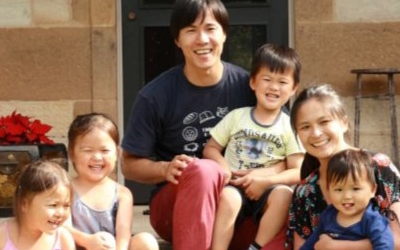
Finding a Jesus-shape for our year
The why and how of marking Advent, Lent and other Church seasons.
In recent times, lockdowns and working from home might have muddied our sense of time. Perhaps in a new way we are aware that there are certain ‘clocks’ that influence us.
We all follow some kind of calendar
In Australia, we inherited the idea of four seasons from the northern hemisphere. Indigenous nations have instead recognised anywhere between two and seven seasons as appropriate to different parts of this vast country.
As humans we follow not only these ‘natural’ calendars and seasons, but also those we create as a community. For many of us, perhaps the strongest sense of seasons comes from the school year and the calendar year, which in Australia are closely aligned. The long summer break is followed by the four school terms, interspersed with school holidays, public holidays and long weekends, before the year concludes with the Christmas rush.
There is another more recent calendar also inviting our attention, the shopping calendar, which encourages us to plan ahead for all the big sales and is aligned with the financial year.
By creating calendars and seasons like these, we ‘make time’ and order our lives in certain ways. In turn, these clocks influence the way we live and the things we give our attention to. We are all living according to some kind of rhythm. The question is what these rhythms say about us, and what they do to us.
Trying out a new rhythm
When Tamie and I moved our family overseas some years ago, we knew we would not have access to the kind of community and supports we had been used to. As a result, we were looking for things we could do that would help us keep drawing close to one another and to God.
One of these was the Jesse Tree, a kind of cross between an Advent calendar and a Christmas tree. We hung a small felt ornament each day of Advent season, each with a new phrase to say. Together these take us through the whole Bible as an unfolding story finding its fulfilment in Jesus. He is the green shoot sprouting from the broken stump of Jesse’s family to become the long-awaited Messiah of Israel and the hope of nations. You can listen to a recording of Tamie and our five-year old telling the story.
As we followed this simple daily exercise, we began to anticipate Christmas more. We found we had more room to receive the full meaning of the celebration. This was a practice or discipline. Following the Jesse Tree regularly became a habit, and this routine began to guide and shape us.
Inspired by the Jesse Tree, Tamie developed a Lenten cross. Each day, a small card goes up on the wall, eventually forming the shape of a cross. The first half covers Jesus' ministry, and the second half concentrates on the Passion week as Jesus prepares for his execution and enthronement as king. Each card has a phrase that goes with it, so that by the end, we are reciting a summary of the gospel.
(You can read more about what we do and download Tamie’s list of readings.)
There are several factors we have found helpful in creating each of these practices:
• it is daily, creating a sense of momentum
• it is low-prep, with a simple format that doesn’t change much from year to year once you have created the materials
• it is brief, allowing for the attention span of little ones (five minutes is good)
• it is engaging, so that little ones can easily take part and older ones can begin to lead
• it is around meal time, so that it becomes a natural part of the day
• it is multisensory, with visual and tactile elements as well as verbal
Learning about a different calendar
Our family did not originally set out to change our calendar. However, since beginning to follow Advent and Lent, we have begun to sense these practices ‘making time’ for us, and we have hoped to keep growing this.
It turns out that Advent and Lent—along with Christmas and Easter—are just some of many moments in the ancient Christian calendar (or liturgical calendar).
The year begins around the end of November with Advent, leading up to the birth of Jesus at Christmas, then working its way during Lent towards his death and resurrection at Easter, followed by his Ascension, then finally his sending of the Holy Spirit at Pentecost, 50 days after Easter.
This means that over the course of six months, every year, we are walking through the entire gospel of Jesus, from his prophesied coming to his pouring out of his Spirit on us, the Church. It includes times of feasting and celebration as well as times of fasting and longing.
The rest of the year is known as 'ordinary time', which originally referred not to normality but to 'ordering', the counting of the weeks. This time is for looking at the progress of the people and what Jesus is doing among us. One month of ordinary time is now being used as a season of creation, for focusing on God's world and everything in it (Psalm 24:1).
There is a helpful written and visual summary of the Church calendar here. I have also found Wikipedia useful for learning more.
How the Church calendar shapes us
The seasons of the Church calendar help us to make room for God not just in the day-to-day, but also the week-to-week and month-to-month. It gives a Jesus-shape to our whole year.
This helps us know his story, the gospel, drawing together the ancient story of Israel and creating a new reality in our own world. It also gives us the opportunity to walk through Jesus’ story together with him, allowing our lives to revolve around him. The gospel is not something from a bygone era but points to a ‘new creation’ reality we are called to live in.
The Church calendar also enables people of all ages to explore and express faith in Jesus. It exhibits a range of emotional experience: this story can become dark and difficult, yet God keeps walking alongside his people throughout.
Because this calendar has broad similarities across the different branches of Christianity, it can also remind us that we belong to a truly global family, a ‘great cloud of witnesses’ (Hebrews 12:1), the multitude ‘from every nation, tribe, people and language’ that God is creating (Revelation 7:9).
It also helps us set ourselves apart from the world order. The highs and lows of the church year are richer and more extended than school holidays and public holidays. We march to the beat of a different drum because our lord is a different Lord. Living in a kingdom which is 'not from this world', our way of life will not match up exactly with Australian ways. This does not necessarily mean that we opt out of ordinary Australian events, but it does encourage us to look for intentional ways in which to recalibrate our time.
As we seek to give our year a Jesus-shape, we pray that our routines will in turn shape us to become more like Christ in this world.
---
Arthur Davis and his wife Tamie are missionaries with CMS Australia. Arthur is staff coach for Tanzania Fellowship of Evangelical Students (TAFES) and Tamie is doing a PhD on the theology of TAFES women graduates.

Farewell Messages of Jesus
In 'The Farewell Messages of Jesus', David Mulready explores John’s account of the last weeks of Jesus’ earthly ministry as he prepares his disciples for his departure. As well as the forty daily devotions, there are sets of questions for personal or group reflection. Also included are outlines of six talks that may be useful for churches or other groups. This study guide can be used in the weeks leading up to Easter or at any other time.
For more articles from Growing Faith, subscribe to our monthly e-newsletter.
To hear about the latest books and resources from Youthworks Media, subscribe here.








